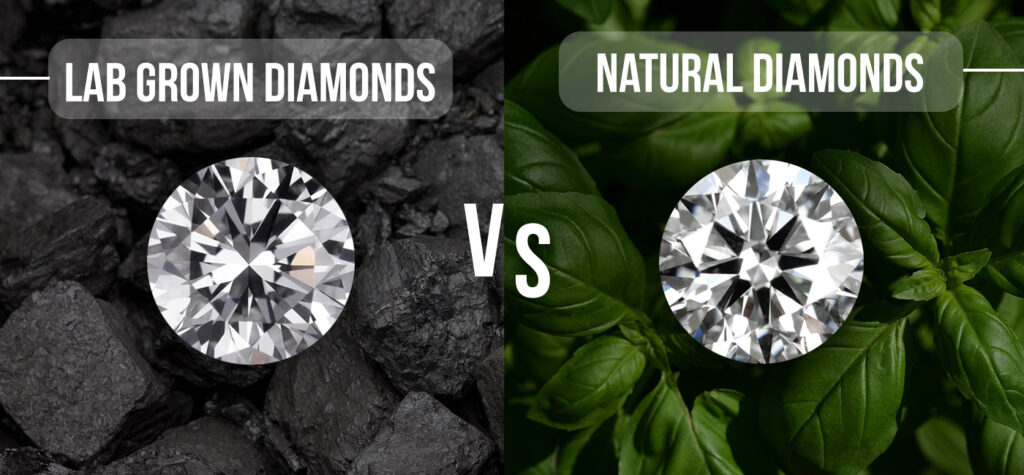
When shopping for an Three stones engagement rings, one of the most significant decisions you’ll face is whether to choose a lab-grown diamond or a natural diamond. Both options offer stunning brilliance and beauty, but there are notable differences that may influence your choice. At KRK Jewels, we believe it’s essential to understand the distinctions between these two types of diamonds so you can make an informed decision that aligns with your values, style, and budget.
1. Formation Process: How They’re Created
Natural Diamonds:
Natural diamonds form deep within the Earth’s mantle over billions of years under intense heat and pressure. Carbon atoms bond in a crystalline structure, and through geological processes, they are brought to the Earth’s surface. The rarity of natural diamonds comes from the fact that the process takes such an incredibly long time—anywhere from 1 to 3 billion years. Natural diamonds are mined from the Earth, a process that involves extracting raw material and refining it into the precious gemstone you see in engagement rings.
Lab-Grown Diamonds:
Lab-grown diamonds, also known as synthetic diamonds, are created in a laboratory using two different processes that replicate the natural formation of diamonds: High Pressure High Temperature (HPHT) or Chemical Vapor Deposition (CVD). These methods replicate the conditions found in the Earth’s mantle but in a much shorter time frame, usually between 6 to 12 weeks. This makes lab-grown diamonds an attractive option for couples looking for high-quality stones at a more affordable price.
Despite the difference in creation methods, lab-grown diamonds are chemically, physically, and optically identical to natural diamonds. They are made of pure carbon and possess the same brilliant sparkle, hardness (10 on the Mohs scale), and clarity as natural diamonds. In fact, to the naked eye, there is no difference between a lab-grown and natural diamond.
2. Appearance and Quality
Both lab-grown and natural diamonds are graded by the 4 Cs: Cut, Color, Clarity, and Carat weight. This grading process ensures that diamonds are assessed based on their visual characteristics.
Natural Diamonds:
Natural diamonds can often contain inclusions (small imperfections) or slight color variations that develop over millions of years of natural formation. These inclusions make each natural diamond unique, as they tell the story of its creation. Some inclusions are visible to the naked eye, while others are only visible under magnification. The natural color of diamonds can vary, ranging from colorless (D grade) to light yellow or even brown.
Lab-Grown Diamonds:
Lab-grown diamonds can often be created with higher clarity and fewer inclusions compared to natural diamonds. Since they are produced in a controlled environment, manufacturers can carefully control the conditions in which the diamond forms, leading to fewer imperfections. Lab-grown diamonds also come in a wide range of colors, with many available in near-colorless or colorless grades. While natural diamonds may take longer to form, lab-grown diamonds can be produced in a much shorter time frame and with higher precision.
3. Cost Differences: Is One More Affordable?
One of the biggest distinctions between natural and lab-grown diamonds is their price. Due to the differences in their formation processes, lab-grown diamonds are significantly more affordable than natural diamonds. Here’s why:
Natural Diamonds:
Natural diamonds are expensive because they are rare, and mining them is a costly, time-consuming process. The price of natural diamonds also includes the cost of exploration, extraction, refinement, and transportation. Additionally, diamond prices are influenced by factors such as market demand, diamond size, quality, and even the brand’s reputation.
Lab-Grown Diamonds:
Lab-grown diamonds are 20–40% cheaper than their natural counterparts, primarily because their creation process is quicker and less resource-intensive. Since they do not have to be mined, the overall costs associated with producing a lab-grown diamond are lower. For example, with a $5,000 budget, you could buy a larger lab-grown diamond than a comparable natural diamond of the same price. This allows for more flexibility in choosing a stone with better clarity, cut, or carat weight while staying within your budget.
4. Environmental and Ethical Impact
Another important factor to consider is the environmental and ethical impact of diamonds.
Natural Diamonds:
Mining natural diamonds can have a significant impact on the environment. It involves extracting minerals from the Earth, which can lead to habitat destruction, deforestation, and the depletion of natural resources. Additionally, diamond mining has been associated with ethical concerns in certain regions, including the exploitation of labor and financing of conflict (often referred to as “blood diamonds”). However, many diamond companies now adhere to the Kimberley Process Certification Scheme, which ensures that diamonds are ethically sourced and conflict-free.
Lab-Grown Diamonds:
Lab-grown diamonds are a more environmentally-friendly option. They don’t require mining and have a smaller carbon footprint. While there is still energy involved in the creation process, companies that produce lab-grown diamonds are increasingly using renewable energy sources, making them a more sustainable choice for eco-conscious consumers. Additionally, since lab-grown diamonds are created in a controlled environment, they can be produced without the same ethical concerns associated with some natural diamond mining operations.
5. Value and Resale
Natural Diamonds:
Natural diamonds are generally seen as long-term investments because they tend to retain their value better over time. A high-quality natural diamond can be passed down through generations, maintaining its worth and appeal. However, market fluctuations can still affect their resale value.
Lab-Grown Diamonds:
Lab-grown diamonds, while beautiful and affordable, may not retain their value as well as natural diamonds. Because lab-grown diamonds are man-made and can be produced in large quantities, they are more likely to lose value over time, especially in the resale market. That being said, they are still a stunning option for those who prioritize beauty and ethical sourcing over investment value.
Which Diamond Is Right for You?
The decision between a lab-grown diamond and a natural diamond depends on your priorities. If budget and environmental impact are important to you, a lab-grown diamond may be the best choice. They offer exceptional beauty at a fraction of the price of natural diamonds, allowing you to purchase a larger or higher-quality stone.
If you prefer the rarity and longevity of a diamond that’s billions of years old, a natural diamond might be the right choice. While they are more expensive, they carry a sense of tradition and rarity that some people find appealing.
At KRK Jewels, we offer both natural diamonds and lab-grown diamonds in stunning engagement ring designs. Whether you choose a solitaire, halo, or vintage setting, we can help you find the perfect ring that fits your style, values, and budget.







